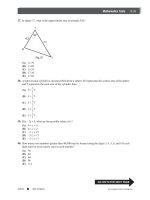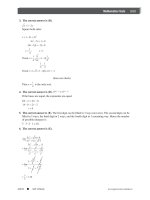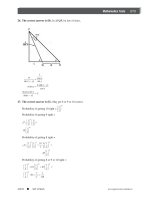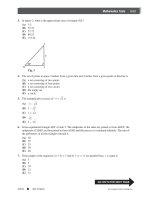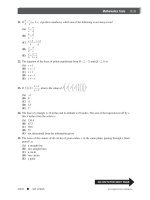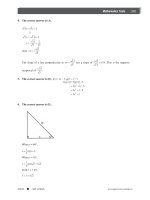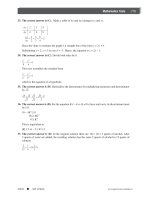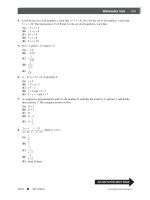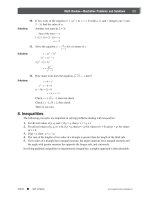SAT II Biology Episode 2 Part 2 potx
Bạn đang xem bản rút gọn của tài liệu. Xem và tải ngay bản đầy đủ của tài liệu tại đây (134.83 KB, 20 trang )
Chapter 8
BEHAVIOR AND ECOLOGY
OVERVIEW
The two areas included in this chapter take an even broader view of
living things. Starting with animal behavior, we explore the way that
animals interact with their environment as an individual behavioral
matter, and specifically how they learn and react to their surround-
ings. Following this, we outline what we know about how animals
communicate, move, feed, and interact socially. Finally, we look at
circadian rhythms. The second section is involved with an even
broader view than the individual behaviors covered in the first
section. Taking a worldview, we outline what the student may be
tested on, beginning with the relationships between members of a
population and their involvement with other species at a community
level. We outline the different kinds of communities within the
biosphere and, by including the abiotic factors, we study the interac-
tions between the biosphere, the hydrosphere, the lithosphere, and
the atmosphere on this planet in different regions and climes called
biomes. From there, a worldview, literally, is outlined in summing up
the relationships of all living things to each other and the planet and
the changes they—living things and the planet—undergo.
ANIMAL BEHAVIOR
This is an area not specifically covered in any of the other areas in
this book, but it actually brings together several factors in describing
the way life expresses itself, given the interaction of all those other
factors. In addition to learning, the areas covered alternately relate to
the individual, groups, and their interactions. Some of the areas
covered involve the study of influences outside the individual; others
involve those that “come with the package.” The argument persists as
to whether nature or nurture dominates life. Do we come with a
prepackaged set of formative influences, or do the environment and
our response to it shape everything?
LEARNING
This is usually defined as acquiring information or a behavior that was
not previously a part of the organism and tends to be brought about
by experience. We now know that behavior has a genetic component
that influences the individual’s relations with the environment and
197
Peterson’s n SAT II
Success: Biology E/M www.petersons.com
with other individuals. An example is the case of reproductive
success or survival fitness. Evolution and natural selection are seen to
enhance these genetically conferred traits.
Conditioning
Conditioning is defined as exhibiting a behavior as a result of a
response to a particular set of conditions, known or unknown,
usually called a stimulus. Care should be taken not to “run around in
circles” on the matter of stimulus/response. A stimulus is anything
that results in activity; a response is the result produced.
A. Classical
Classical conditioning, or associative behavior, is of course, given in
Pavlov’s classical “salivating dog” experiment and is taken as respond-
ing to a substitute stimulus rather than the original or expected
stimulus.
B. Operant
Operant conditioning is more of a trial-and-error kind of conditioning.
The closer an individual gets to the desired response with positive
reinforcement, the more the individual will repeat the response. This
occurs in animal training, but it can also be seen in an animal that
spends initial energy on revisiting a feeding site that has yielded
success in the recent past.
Imprinting
This behavior is an example of one that appears to involve a “critical
period.” It occurs only if the right stimulus occurs during a particular
time. Examples would be salmon returning to the precise site of their
birth or, as in Lorenz’s studies, with goslings.
Habituation
Habituation involves a behavior in which unproductive results are
soon disregarded, and the stimulus that causes them is also disre-
garded eventually.
Insight
Without any previous experience with a situation, an animal performs
a successful behavior, most likely influenced by previous behaviors.
Observational
Individuals copy the behavior of another without having previously
experienced the stimulus that produces that behavior.
CHAPTER 8
198
Peterson’s n SAT II
Success: Biology E/Mwww.petersons.com
INNATE
Behaviors, or the potential for them, that already exist inside the
individual are called innate.
Fixed action pattern
These follow a regular, unwavering pattern that is initiated by a
specific stimulus and carried out even in the absence of the ability to
complete the original intent.
Instinct
Instinct is the classic innate behavior that has no other explanation
other than that it is inherited. One such behavior appears to deal
with time and is known as circadian rhythm. Internal clocks or cycles
appear in part to have a genetic basis to an organism’s interaction
between the environment and chemical promoters in the individual.
MOVEMENT
Animals have particular ways in which they move. Three specific
ways have been identified, and they involve very specific actions
according to the organisms and the environment in which they
reside.
Kinesis
Kinesis is a random change in speed and/or direction of an organism
in response to a stimulus. It will, for example, speed up in an
unfavorable environment and slow down in a favorable one.
Taxis
Taxis is a very specific, directed response to a stimulus, in the
direction of the stimulus if it is favorable and away from the stimulus
if it is unfavorable.
Group
Group movement, better known as migration, is the wholesale
movement of animals that is usually brought on by seasonal influ-
ences, in particular the availability of food.
COMMUNICATION
Communication is usually observed within a species to recognize
one’s own kind for mating, for social behavior, or for the avoidance
of a nearby predator.
BEHAVIOR AND ECOLOGY
199
Peterson’s n SAT II
Success: Biology E/M www.petersons.com
Chemical
Chemical communication uses pheromones, which trigger a response
when smelled or, in some cases, when eaten. In the case of bees, the
workers eat a pheromone, and it prevents them from developing
reproductive ability.
Visual
Visual communication is usually observed during courtship or
aggressive behavior when defending territory or establishing pecking
order. In some, visual displays by males are releasers for reproductive
behavior in females.
Auditory
Auditory communication may be for definition of territory; for species
recognition, as in the case of a mating behavior; or for alerting
behavior, as when a predator is nearby.
Tactile
Tactile communication is a common behavior in bonding, infant care,
and mating. In bees, it is even used to locate successful food sources.
FEEDING
Feeding behaviors that organize the search for food have been
observed and appear to impact the survival of the species and have,
therefore, great impact and importance for the individual, even as the
individual may relate to a group.
Groups
Groups of individuals have evolved several successful means of
feeding or finding food.
A. Herds
Herds use this kind of group behavior when feeding as a means of
defending against predators by shielding each other, when attempting
to avoid a predator by becoming hidden from view, or simply by
being alert to the presence of a predator. A member on one end of
the herd may not be aware of a predator approaching the other end
of the herd.
B. Packs
Packs engage in group hunting, which is most often observed when
smaller species attack a larger one.
CHAPTER 8
200
Peterson’s n SAT II
Success: Biology E/Mwww.petersons.com
Search image
Animals will seek food based on the success previously experienced
or on images they possess, however limited, of the target previously
experienced. A measure of habituation obviously contributes to the
success of this feeding behavior.
SOCIAL
Individuals behave in two different settings: in a group or on their
own. Eventually, they will make contact with other organisms within
their species or outside their species. The most successful interac-
tions survive, as do the individuals or the groups that exhibit them.
Agonistic
Agonistic behavior is aggressive/submissive behavior that actually has
great survival value, since it is most often quite ritualized and,
therefore, actually reduces negative aspects of aggression.
Dominance
Dominance establishes hierarchies, or “pecking order,” and also
minimizes conflict within the group.
Territoriality
Territoriality is a behavior that ensures a food supply, a place for
reproductive activities, and successful rearing of infants.
Altruistic
Altruism is seemingly unselfish behavior that is not beneficial to, or
may be harmful to, an individual but that actually increases the fitness
of the group by ensuring survival of the species and parental genes.
ECOLOGY
The word ecology comes from the root ecce, meaning home or place.
If, in several instances, we have talked about the big picture, this is
the biggest of all. All of the material discussed so far culminates in the
study of our environment or ecology, the study of “this place.”
BIOSPHERE
The biosphere is the realm of living things, along with the hydro-
sphere, lithosphere, and atmosphere, that make up our world.
BEHAVIOR AND ECOLOGY
201
Peterson’s n SAT II
Success: Biology E/M www.petersons.com
The Earth
The earth includes the four “spheres” and the ways in which they
interact.
Major Biomes
Under the influence of latitude or elevation and various abiotic,
nonliving factors, the earth is divided into large areas known as
biomes, areas of distinctly different living things. Beginning with the
most inhospitable, because it is the coldest, we begin at the “top” of
the world. While reference will be made only to latitude as we
progress toward the equator, one can also find similar conditions
when descending a mountain.
A. Tundra
The northernmost biome is tundra, which contains rapidly maturing
plants, a permanent layer of ice under the soil, and mostly small
homeotherms.
B. Taiga
Taiga is less forbidding. It nonetheless has long cold winters; larger
plants, such as stunted conifers, exist; and there are more large
animals.
C. Temperate deciduous forests
Temperate deciduous forests contain larger trees that lose their leaves
in dry—usually winter—seasons, proliferate heterotrophs and
autotrophs, and have warm summers and colder winters.
D. Grasslands
Grasslands feature hot summers, cold winters, unpredictable rainfall,
mostly grassy autotrophs, and a fairly wide variety of wildlife.
E. Deserts
Deserts contain drought-resistant plants, low rainfall, a very dry
climate, small homeotherms, and proliferate reptilia.
F. Tropical rain forests
The tropical rain forests are the most proliferate of all biomes for
living things, containing high rainfall and temperatures and poor soil.
ECOSYSTEM
An ecosystem is smaller than a biome and is most often a self-
contained area, such as a lake or a tidal pool.
CHAPTER 8
202
Peterson’s n SAT II
Success: Biology E/Mwww.petersons.com
Abiotic factors
Abiotic factors are nonliving factors that include air, water, topogra-
phy, geology, and sun. The interactions of these include things like
temperature, humidity, wind, and erosion.
Biotic factors
Biotic factors are living things in an ecosystem and the way they
interact.
A. Producers
Autotrophs are known as producers since, in the presence of the
ultimate source of energy—the sun—they provide most of the
biomass.
B. Consumers
As the name suggests, these consume biomass but are not capable of
producing or using sunlight directly to create a food source, as the
autotrophs are. Consumers are usually divided into at least primary
consumers, whose primary source of nutrition is producers, and
secondary consumers, whose primary source of nutrition is another
consumer.
1. Herbivore—designed to metabolize producers exclusively
2. Carnivore—designed to metabolize other consumers exclusively
3. Omnivore—designed to metabolize both producers and consum-
ers
C. Decomposers
At some point, the complex molecules that living things construct
from their nutrients must be broken down lest the environment run
out of raw materials that some organisms need to carry on life. This is
the role of the decomposers.
FUNCTIONING
The biotic world functions at several levels, which are outlined here.
Food chain
The food chain consists of a linear interaction between organisms in
which the starting point is usually a plant, which is consumed by the
next organism, which is consumed by the next organism, and so on,
until the chain ends. It can be portrayed vertically in what is called a
food pyramid that more accurately portrays the amount of biomass at
each level in the chain (called a trophic level).
BEHAVIOR AND ECOLOGY
203
Peterson’s n SAT II
Success: Biology E/M www.petersons.com
Food web
The food web is several food chains interacting. For example, a
mouse might not just eat corn; it might also eat nuts or grains.
Community
A community is a group of populations living in the same area.
A. Habitat
A habitat is the place where organisms usually live.
B. Niche
A niche consists of all the living and nonliving sources that contribute
to an animal’s survival—or, more accurately, a species survival—as a
result of successful achieving of equilibrium with these factors by the
animal (species). A niche is an organism’s “job,” or what it does in an
ecosystem.
C. Biodiversity
Biodiversity is the variety of living things, their ecological functions,
and the variety of genes they contain.
SYMBIOSIS
Symbiosis refers to relationships where animals are in proximity to
each other and interact as a result. Literally, it means “living to-
gether.”
Camouflage
Camouflage is the successful concealment from view of an organism,
usually from its predator.
Commensalism
Commensalism is an interaction between organisms where one
benefits and the other is not harmed or benefited.
Mimicry
Mimicry is similar to camouflage in that a protective appearance has
evolved, but this might be displayed rather than concealed, since it
might resemble a predator of an attacker or, at the very least, a more
aggressive or distasteful organism than the attacker planned on
encountering.
CHAPTER 8
204
Peterson’s n SAT II
Success: Biology E/Mwww.petersons.com
Mutualism
Unlike commensalism, both organisms benefit in mutualistic interac-
tion.
Parasitism
Parasitism must strike a delicate balance between the parasite and the
organism off of which it lives, mainly the host. The parasite-host
relationship is one in which one organism is helped; the other—the
host—is harmed but not killed.
Predator/Prey
The killing of the prey benefits the predator.
POPULATION STUDIES
This very important area of science is applied primarily to the study
of human populations, although the principles relate to all lines of
living things. Generally, the areas of study seek to determine the
nature of the population, particularly its health or equilibrium with
the environment.
Size
The number (N) of individuals in a population.
Density
N per unit of volume—not area since some organisms occupy a
three-dimensional cross-section of the niche.
Dispersion
How the population is distributed.
BEHAVIOR AND ECOLOGY
205
Peterson’s n SAT II
Success: Biology E/M www.petersons.com
Age structure
The N of each age group, diagrammed along a vertical line that
separates male and female members of the population on either side,
results in specific shapes that can be interpreted as population trends.
Mortality
Mortality is the survival of individuals throughout their lifetime.
Growth
Two organisms and their life strategies emerge from our studies of
populations. Their growth is the result of these strategies as they
impact the environment, and vice versa. The r-selected species have a
lifestyle of rapid invasion, rapid increase—from birth rates that
involve many small offspring that mature quickly—and rapid decline.
On the other hand, K-selected species’ numbers remain at the
carrying capacity and have few, relatively large offspring who require
much care.
A. Biotic potential
Maximum growth rate of a population under ideal conditions for all
the factors just discussed, always, however, tempered by environmen-
tal resistance.
CHAPTER 8
206
Peterson’s n SAT II
Success: Biology E/Mwww.petersons.com
B. Carrying capacity
Indicated by the use of K, it is the maximum N that can be sustained
by a particular ecosystem.
C. Limiting factors
Those factors in a habitat that prevent a population from reaching its
maximum N or biotic potential.
1. Density dependent—limiting factors that depend on the size of
the population and have greater and greater effect on the
population as the population grows, such as competition for
food, dispersal of wastes, and reproductive behaviors.
2. Density independent—those factors that do not have a differen-
tial effect on the population, depending on the size of the
population. Natural disasters and weather/climate extremes are
among the density-independent limiting factors.
D. Exponential
Exponential growth occurs when the birth rate is .0, making the
increase in population exponential. When graphed it typically follows
a J-shape as the slope continues to increase towards a 90° incline.
E. Logistic
Logistic growth occurs when limiting factors restrict the growth rate
to the available resources (carrying capacity). It is represented by an
BEHAVIOR AND ECOLOGY
207
Peterson’s n SAT II
Success: Biology E/M www.petersons.com
S-shaped, or sigmoid, curve that typically plateaus when the popula-
tion reaches equilibrium with the carrying capacity.
SUCCESSION
As the name suggests, it is the change in the make-up of populations
in a community over time, ending with a climax community for that
biome.
Primary
Primary succession is the first instance where an area will experience
succession; the area has never before experienced living things, as in
immediately after a lava flow cools.
Secondary
Secondary succession occurs when an area previously occupied by
living things is completely destroyed, as in a forest fire or a flood that
complete washes out an area.
EVOLUTION
Evolution involves the process by which species (not individuals)
change over time. Members of a species show random inherited
variations. For example, dogs show variations in height, weight, fur
color, type of ears, and other traits. Changes in the environment will
favor organisms with certain variations (the fit) that permit them to
survive and reproduce more than members of the population that are
less fit. This is called natural selection and is an important mechanism
in evolution.
Evolution contains the hypothesis that all living species are
derived from other species; that all life shares a common ancestor;
and that all life is constantly changing. Evidence for this hypothesis is
far reaching and substantial. It includes fossil records, comparative
CHAPTER 8
208
Peterson’s n SAT II
Success: Biology E/Mwww.petersons.com
anatomy and biochemistry, and biogeography. Evolution also has been
experimentally demonstrated in the laboratory and in nature.
The evolutionary aspects of comparative anatomy can be
followed by a review of the phylas discussed in Chapter 6.
Charles Darwin
Receives primary credit for developing the Theory of Evolution after
taking a trip around the world as a naturalist on the HMS Beagle.
Alfred Russel Wallace
Independently co-discovered natural selection as a mechanism in
evolution.
Jean-Baptiste de Lamarck
In the late 1700s had proposed descent with modification, but
erroneously thought characteristics acquired in one generation could
be inherited by succeeding generations.
The Theory of Evolution
Now considered one of the basic theories of biology.
BEHAVIOR AND ECOLOGY
209
Peterson’s n SAT II
Success: Biology E/M www.petersons.com
MULTIPLE-CHOICE QUESTIONS
Questions 1–4 refer to the following relationships:
(A) predator-prey
(B) commensalism
(C) mutualism
(D) parasitism
(E) camouflage
1. A cow produces milk daily after grazing in a large pasture owned
and maintained by the farmer.
2. Remora fish attach themselves to the underside of a shark, and
while the shark feeds, the remora darts out for shreds of the
shark’s food that are left floating in the water.
3. A walking stick resembles the branches it resides on.
4. Lacking a digestive system, tapeworms live in the intestines of
their host.
5. Which of the following organisms in the food chain has the
largest biomass?
(A) plants
(B) grasshopper
(C) mouse
(D) owl
(E) snake
6. Which of the following is an instinct?
(A) caring for offspring
(B) habituation
(C) operant conditioning
(D) associative behavior
(E) observational learning
CHAPTER 8
210
Peterson’s n SAT II
Success: Biology E/Mwww.petersons.com
7. In the graph below, the curve indicates the
(A) biotic potential.
(B) carrying capacity.
(C) density-dependent effect.
(D) density-independent effect.
(E) sigmoid curve.
8. All of the following are associated with mating behavior EXCEPT
(A) aggressive behavior.
(B) releaser pheromones.
(C) search image.
(D) territoriality.
(E) visual communication.
9. Which of the following biomes is characterized by the driest
conditions?
(A) tundra
(B) taiga
(C) temperate deciduous forest
(D) grasslands
(E) tropical rain forest
BEHAVIOR AND ECOLOGY
211
Peterson’s n SAT II
Success: Biology E/M www.petersons.com
10. Which of the following is NOT a means of animal communica-
tion?
(A) auditory
(B) chemical
(C) instinctual
(D) tactile
(E) visual
EXPLANATIONS OF ANSWERS FOR MULTIPLE-CHOICE QUESTIONS
1. The correct answer is (C). The relationship indicated in this
question benefits both individuals and so would be a case of
mutualism. The next closest would be commensalism, but, in this
case, both, not one, are benefited.
2. The correct answer is (B). This relationship is the case where
commensalism is illustrated. While the shark is not harmed by
the relationship, neither is it benefited. Only the remora benefits
from the free transportation and the ready supply of food.
3. The correct answer is (E). Since the walking stick resembles
the branch on which it lives, it is hidden from the view of
predators as it camouflages itself by such an adaptation.
4. The correct answer is (D). Using another species for its
survival by taking some part of its host’s means of survival, the
tapeworm is acting like a parasite. Due in part to its own lack of
a digestive system, the tapeworm must achieve a balance,
through its reproductive behavior, with the host lest the tape-
worm kill the host, which would mark the demise of the
tapeworm itself. In a parasite-host relationship, the parasite must
reach a balance with the host that does not kill the host.
5. The correct answer is (A). If we construct the food chain with
the members we are given as a food pyramid, we see that it must
begin with the plants in a position at the bottom and widest part
of the pyramid, which indicates that it represents the largest
biomass. As we continue up the pyramid, or chain, the amount
of material—which houses the main ingredient in the picture,
that of energy—decreases dramatically between levels. The end
result is that 10 percent of the energy, on average, of any one
level is passed on to the next level. The owl, which we might
find at the top of this food pyramid, has the least amount of
biomass. Next comes the snakes the owl consumes with more
biomass, just below the owl on the pyramid. More so the mouse,
CHAPTER 8
212
Peterson’s n SAT II
Success: Biology E/Mwww.petersons.com
even more so the grasshopper, until we reach the bottom, where
the largest amount of biomass is found in the plants.
6. The correct answer is (A). Choices (B) through (E) are all
forms of learned behavior and involve a necessary interaction
with the environment to take place. Caring for an infant seems to
be one of those behaviors that is instinctual in most species.
Habituation is the active disregarding of unnecessary stimuli.
Operant conditioning is the trial and error kind of learning
associated with acts such as training. Associative behavior is the
classical form of conditioning where an animal associates a set of
behaviors with a successful result, usually after repeated encoun-
ters. Observational learning is associated with mimicking anoth-
er’s behavior after close observation.
7. The correct answer is (E). The entire graph is known as a
sigmoid graph and represents changes in a population over time.
The plateau indicates equilibrium between the organisms and the
environment. A drop in the graph would indicate increasing
mortality; a rise would indicate increasing birth rate. While biotic
potential is a seemingly attractive choice, this graph is an
indication of the reality of the population. Another line would be
needed to indicate density relations, such as the relation between
r-selected species and K-selected species.
8. The correct answer is (C). Search image has to do with a
feeding or foraging behavior in an organism as it seeks food
sources of which it has retained a somewhat abbreviated image.
All of the other behaviors impact mating behavior by establishing
dominance, triggering a behavior by chemical means, establishing
a territory of ownership, or by a display that the opposite sex
recognizes or which triggers reproductive behavior in the
opposite sex.
9. The correct answer is (A). From the list of biomes given, the
tundra classifies as the driest. Although it is covered with water,
this water is frozen and therefore unavailable in the way we
would hope water would be available for any plant or animal
use. The taiga, with a period during which the water is frozen,
also has a time when it is liquid and available for use. Temperate
deciduous forests are more wet, and tropical rain forests are the
wettest of all. Grasslands fall somewhere in between the taiga
and temperate biomes. If there were more moisture in the
grassland biome, it could support larger plants. On the other
hand, it must have enough moisture to support the grassy plants
throughout a growing season.
10. The correct answer is (C). Animals communicate through a
variety of means. Sound, chemical, touch, and sight are all ways
BEHAVIOR AND ECOLOGY
213
Peterson’s n SAT II
Success: Biology E/M www.petersons.com
that animals communicate with each other. Instinctual is not a
means of communicating; rather, it is how the organism re-
sponds to environmental needs without appearing to learn these
responses.
VOCABULARY
associative learning
autotroph
behavior
biomes
biosphere
carrying capacity
circadian rhythms
classical conditioning
climax community
commensalism
community
consumer
critical period
decomposer
density-dependent factors
density-independent factors
ecology
ecosystem
exponential growth
fauna
flora
food chain
food pyramid
food web
herbivore
heterotroph
imprinting
insight
instinct
K-strategists
learning
logistic growth
mutualism
niche
operant conditioning
parasitism
pioneer community
population
population density
primary consumer
producer
reasoning
r-strategists
secondary consumer
sere
succession
trophic
CHAPTER 8
214
Peterson’s n SAT II
Success: Biology E/Mwww.petersons.com
Chapter 9
LABORATORY
OVERVIEW
Testing laboratory skills on a multiple-choice test is almost impossible.
However, some lab experience will be helpful in preparing for and
actually taking the SAT II Biology exam. Therefore, you may find our
review book helpful in providing as much information in this chapter
and others as you should reasonably be expected to know in order to
be successful on this part of the test. We will outline what the lab is
about, what you need to know to successfully deal with the lab, and
any tips that might be helpful. In the “First Things” section, we
briefly describe what the student will do in the lab, despite the fact
that the student may not actually have the opportunity to do the lab.
In “The Basics,” we indicate what the student should know before
doing the lab and what the expected outcomes are; finally, in the
“Last Things” section, we provide any additional information the
student should know.
LABORATORY 1—DIFFUSION AND OSMOSIS
FIRST THINGS
The student will demonstrate a competency in investigating the
processes of diffusion and osmosis and the effect of solute concentra-
tion on water potential in plants.
THE BASICS
In order to be successful on this lab, the student should understand
(a) the mechanisms of both processes, (b) water potential, (c)
differentially (selectively) permeable membranes and their effect on
the two processes, (d) molarity, and (e) the relationship between
water potential and solute concentration. Following this lab, the
student will be able to (a) measure water potential of a solution, (b)
determine the osmotic concentration in living plant tissue, (c) relate
the effects of water gain or loss in living tissue, and (d) relate osmotic
pressure to solute concentration and water potential.
215
Peterson’s n SAT II
Success: Biology E/M www.petersons.com
LAST THINGS
The student should be familiar with the fact that the free energy in
water is known as its water potential. The terms hypotonic and
hypertonic should be well known, as well as turgor pressure. Finally,
the student should be familiar with the basics of the movement of
water across a membrane and its effect in animal and plant tissue.
LABORATORY 2—ENZYME CATALYSIS
FIRST THINGS
The student will measure the action of the enzyme catalase on
hydrogen peroxide and the rate at which it is converted to water and
oxygen gas.
THE BASICS
In order to be successful on this lab, the student should understand
(a) enzymes, their structure, and how they act; (b) free energy; and
(c) initial reaction rates of enzymes and the conditions that affect
them. After performing this lab, the student should understand how
to (a) measure the effects of temperature, pH, and enzyme/substrate
concentration on enzyme-mediated catalysis and (b) explain the effect
that environmental factors have on enzyme-catalyzed reactions.
LAST THINGS
The student should be familiar with enzymes and how they act and
how, if they become denatured, they change their shape and thus
their ability to work.
LABORATORY 3—MITOSIS AND MEIOSIS
FIRST THINGS
The student will perform two labs, one on mitosis and one on
meiosis.
A. Mitosis
The student will calculate how long a cell spends in the various
phases of mitosis and will compare animal mitosis with plant mitosis.
B. Meiosis
The student will investigate the stages of meiosis using chromosome
models. This includes crossing over and recombination. The student
CHAPTER 9
216
Peterson’s n SAT II
Success: Biology E/Mwww.petersons.com
